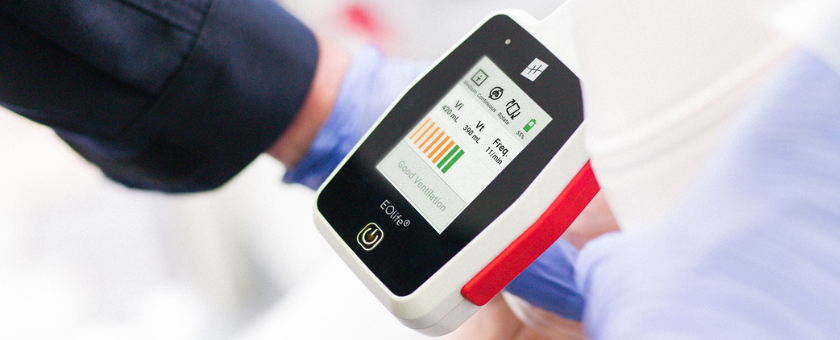As emergency and critical care evolve, so do the tools that support healthcare professionals. Ventilation Feedback Devices (VFDs) such as EOlife are rapidly becoming essential in ensuring high-quality manual ventilation, providing real-time insights that improve both performance and patient outcomes. But what exactly are VFDs, and why are they becoming a new standard in resuscitation and prehospital care? In this article, we explore the rise of these innovative devices and their growing impact on the field.
The core objectives of CPR
During cardiopulmonary resuscitation (CPR), there are two main objectives:
- Perform effective chest compressions to maintain blood flow to vital organs.
- Ventilate the patient to bring oxygen into the body and remove carbon dioxide (CO₂) from the blood.
Both components are critical to delivering high-quality CPR. Chest compressions without ventilation only circulate oxygen-depleted blood, which is not enough to sustain life. Without oxygen, vital organs—especially the brain—are at risk of permanent damage within minutes.
In prehospital settings (like in ambulances or on-scene emergencies), ventilation is most often performed manually using a self-inflating bag, also known as a Bag-Valve Mask (BVM). This device, connected to an oxygen tank and a patient airway (such as a face mask, laryngeal mask, or endotracheal tube), allows rescuers to squeeze air into the patient’s lungs.
Ventilation, a neglected aspect of CPR
Over the past 20 years, most improvements in CPR have focused on chest compressions, with the development of mechanical compression devices (like LUCAS), cardiopumps, and impedance threshold devices. In contrast, manual ventilation has seen very little innovation since the invention of the BVM in the 1950s.
Yet, manual ventilation is a highly complex procedure. Without any feedback, it’s like driving a car without a speedometer: you are completely blind to the quality of what you’re doing.
CPR guidelines from international authorities (like the European Resuscitation Council – ERC and the American Heart Association – AHA) recommend delivering tidal volumes of 6 to 8 mL per kg of body weight, with a target respiratory rate of 10 breaths per minute. But until recently, there was no tool available to help emergency teams meet these precise targets..
The birth of Ventilation Feedback Devices
In the mid-2010s, a new field of innovation emerged: Ventilation Feedback Devices (VFDs). These tools are designed to measure and improve the quality of manual ventilation. The first scientific description of a VFD was published in 2019 by Khoury et al.(1), in their study “Ventilation Feedback Devices for Manual Ventilation in Simulated Respiratory Arrest: A Crossover Manikin Study.”
VFDs are placed between the BVM and the patient’s airway and work by measuring the inspiratory and expiratory airflow. Using advanced algorithms, they calculate critical ventilation parameters like tidal volume (the amount of air delivered to the lungs with each breath) and respiratory rate. They provide real-time visual and/or audio feedback, helping the user adjust their technique and stay within guideline-recommended ranges. Studies have shown that VFDs can improve compliance with ventilation guidelines by over 70%.
EOlife, a revolutionary Ventilation Feedback Devices
Several devices have since been developed to meet this new need. However, only one has been specifically designed to tackle the biggest challenge in manual ventilation: mask leakage. When using a face mask, a significant portion of the air can escape around the mask instead of reaching the lungs. This makes it very difficult to ensure proper ventilation.
EOlife is the only device on the market that can:
- Detect and quantify mask leakage.
- Accurately calculate tidal volume, i.e., the actual volume of air reaching the lungs.
- Provide real-time guidance to optimize ventilation quality.
Thanks to its smart technology, EOlife transforms manual ventilation from a blind procedure into a guided, high-precision intervention. Clinical and simulation studies suggest that using EOlife can triple survival rates and quadruple the chance of good neurological outcomes after cardiac arrest (2).

Improve your manual ventilation with EOlife
Find out more
References
(1) Khoury, A., De Luca, A., Sall, F. S., Pazart, L., & Capellier, G. (2015). Performance of manual ventilation: how to define its efficiency in bench studies? A review of the literature. Anaesthesia, 70, 985-992. doi:10.1111/anae.13097
(2) Idris, A. H., Aramendi Ecenarro, E., Leroux, B., Jaureguibeitia, X., Yang, B. Y., Shaver, S., Chang, M. P., Rea, T., Kudenchuk, P., Christenson, J., Vaillancourt, C., Callaway, C., Salcido, D., Carson, J., Blackwood, J., & Wang, H. E. (2023). Bag-Valve-Mask Ventilation and Survival From Out-of-Hospital Cardiac Arrest: A Multicenter Study. Circulation, 148(23), 1847–1856.


